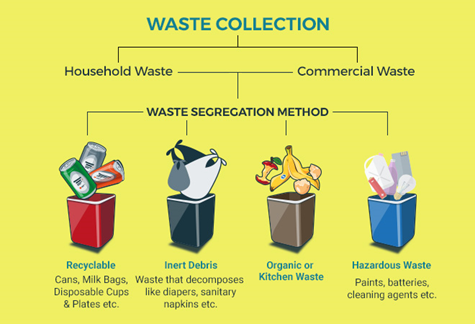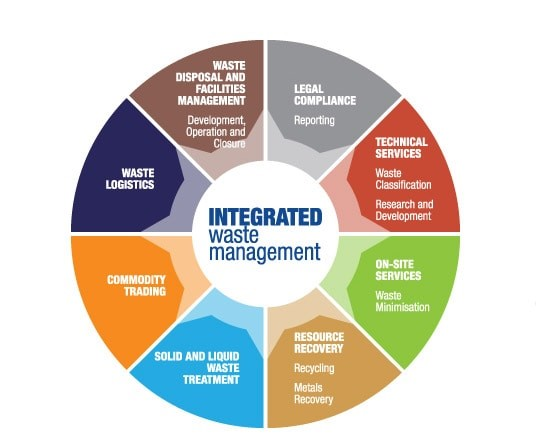Biodiversity & Environment
SWM Cess on Waste Generators
- 20 Jun 2024
- 11 min read
For Prelims: Solid Waste Management Cess, Solid Waste Management, Landfills, Solid Waste Management Rules 2016
For Mains: Issues related to Solid Waste Management, Need for increasing cess of SWM.
Why in News?
Recently, Bengaluru has proposed to increase the Solid Waste Management (SWM) Cess to Rs. 100 per month for each household in order to cope up with the high financial strain in the SWM process.
- Currently, ULBs typically charge about Rs. 30-50 per month for SWM services, which is often collected along with property tax.
What is SWM Cess?
- About:
- Solid Waste Management (SWM) cess is a user fee or charge levied by Urban Local Bodies (ULBs) in India.
- A cess is a form of tax or levy imposed by governments to fund specific services or purposes, such as waste management or infrastructure development.
- Solid Waste Management (SWM) cess is a user fee or charge levied by Urban Local Bodies (ULBs) in India.
- Legal Provisions:
- As per the Solid Waste Management Rules, 2016, ULBs are required to collect user fees or cess for SWM services. The suggested rise in fees is a response to the growing expenses and difficulties encountered by ULBs in efficiently handling solid waste.
What are Solid Waste Management Rules 2016?
- These rules replaced the Municipal Solid Wastes (Management and Handling) Rules, 2000.
- It focused on the segregation of waste at source, the responsibility of the manufacturer to dispose of sanitary and packaging wastes, and user fees for collection, disposal and processing from the bulk generator.
- Key Features:
- Waste Segregation & Disposal: Residents must separate waste into wet (biodegradable), dry (recyclable), and hazardous categories. Segregated waste goes to authorised collectors or local bodies.
- Payments: Residents pay user fees for collection and face fines for littering or not segregating waste.
- Waste Processing: The SWM Rules encourage composting or bio-methanation of biodegradable waste whenever possible. Landfills, waste-to-energy plants, and special handling for hilly areas are also covered by the rules.
- Local Authority Duties: Municipalities collect segregated waste, ensure proper processing/disposal, and levy user fees to cover costs.
- Extended Producer Responsibility: Manufacturers of disposables (packaging) share responsibility for collection and financially support waste management systems.
Other Initiatives Related to Waste Management
- Plastic Waste Management (PWM) Rules, 2016 and Plastic Waste Management (Amendment) Rules, 2022.
- Bio-Medical Waste Management Rules, 2016
- Waste to Wealth Portal: It aims to identify, develop, and deploy technologies to treat waste to generate energy, recycle materials, and extract resources of value.
- Waste to Energy: A waste-to-energy or energy-from-waste plant converts municipal and industrial solid waste into electricity and/or heat for industrial processing.
- Project REPLAN: It aims to make carry bags by mixing processed and treated plastic waste with cotton fibre rags in a ratio of 20:80.
What is Rationale Behind Increasing SWM Cess Collection?
- High Costs of SWM Services: The SWM process is highly complex and resource-intensive, consuming up to 50% of the annual budgets of ULBs.
- The expenses include capital investments, as well as operational costs, including salaries, waste collection, and the functioning of waste management plants.
- Revenue Challenges: Despite the high expenditure on SWM, the revenue generated from these services is minimal.
- For example, Bengaluru spends approximately Rs 1,643 crore in SWM services, while the revenue generated from SWM services, excluding grants received, is almost negligible at Rs. 20 lakh per year.
- Limited Recyclability: A mere 1-2% of dry waste is recyclable, while the bulk of the waste is non-recyclable and non-biodegradable, leading to negligible revenue from recycling efforts, further straining the financial resources of ULBs.
- Operational Challenges: Proper segregation of waste at the source is often lacking, complicating the processing of waste.
- Also, there is a limited market for the finished products derived from waste processing, making it financially unviable.
- Disposal Costs: The disposal of non-compostable and non-recyclable dry waste is a significant expense, particularly due to the transportation costs, as the facilities for proper waste disposal are often located far from urban centers.
Methods of Solid Waste Management
- Recycling: Reprocessing used materials like paper, plastic, metal, and glass into new products reduces reliance on resources and saves energy.
- Landfills: These have been used for disposing of all types of waste as they served as the final destination for materials that cannot be recycled or broken down naturally. Modern landfills employ liners and other containment methods to minimise their environmental impact.
- Incineration: This involves burning waste at high temperatures, which significantly reduces its volume. It also raises concerns about air pollution and the release of harmful pollutants.
- Composting: It offers a natural solution for managing organic waste, such as food scraps and yard trimmings. Through the composting process, these materials are transformed into nutrient-rich fertiliser, which can then be used to enrich soil health.
What Measures can be Taken to Reduce Operational Expenditure on SWM Services?
- Waste Segregation at Source: Improving waste segregation at the household level can increase the yield from composting operations and enhance the recycling of dry waste, thereby reducing operational costs.
- Reducing Single-use Plastic: The increasing prevalence of non-recyclable single-use plastics adds to the transportation and disposal costs for ULBs. Reducing the use of such plastics can help lower operating expenses.
- Decentralised Composting: Setting up Micro Composting Centers (MCCs) at the ward level, as seen in Tamil Nadu and Kerala, can help process wet waste locally and reduce transportation costs.
- Self-Waste Processing by Bulk Waste Generators: Incentivising large institutions and establishments to set up in-house waste processing facilities can help reduce the burden on ULBs and promote cleaner premises.
- Information, Education, and Awareness (IEC): It will help to prevent open littering. Effective IEC campaigns to discourage improper waste disposal can reduce the labour required for sweeping roads and clearing drains, allowing the redeployment of resources to waste processing and value recovery.
Global Waste Management Outlook 2024 Report (GWMO 2024)
- It was released by the United Nations Environment Programme (UNEP) in February 2024.
- Key findings:
- Global Scenario: Over two billion tonnes of municipal solid waste (MSW) are generated annually worldwide.
- Waste Collection: More than a third of the global population, particularly in the Global South and developing regions, faces severe waste management issues, with over 2.7 billion people lacking proper waste collection services.
- Approximately 540 million tonnes of MSW, equating to 27% of the global total, remain uncollected.
- Future Projection: Waste generation is expected to increase significantly, rising from 2.3 billion tonnes in 2023 to 3.8 billion tonnes by 2050.
- Barriers to Waste Management: It include lack of public awareness and education, lack of inclusion in decision-making, technical barriers in extracting recyclable materials from mixed waste, and bureaucratic barriers hindering private sector involvement.
|
Drishti Mains Question: Evaluate the impact of introducing a Solid Waste Management (SWM) Cess to tackle waste management issues and improve environmental sustainability. |
UPSC Civil Services Examination, Previous Year Question (PYQ)
Prelims:
Q. As per the Solid Waste Management Rules, 2016 in India, which one of the following statements is correct? (2019)
(a) Waste generator has to segregate waste into five categories.
(b) The Rules are applicable to notified urban local bodies, notified towns and all industrial townships only
(c) The Rules provide for exact and elaborate criteria for the identification of sites for landfills and waste processing facilities.
(d) It is mandatory on the part of the waste generator that the waste generated in one district cannot be moved to another district.
Ans: (c)
Mains:
Q. What are the impediments in disposing of the huge quantities of discarded solid waste which are continuously being generated? How do we safely remove the toxic wastes that have been accumulating in our habitable environment? (2018)
Q. “To ensure effective implementation of policies addressing the water, sanitation and hygiene needs the identification of the beneficiary segments is to be synchronised with anticipated outcomes.” Examine the statement in the context of the WASH scheme. (2017)
Q. How could social influence and persuasion contribute to the success of Swachh Bharat Abhiyan? (2016)








